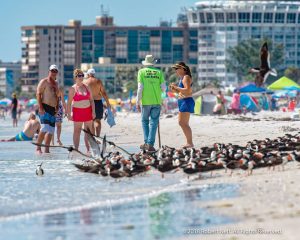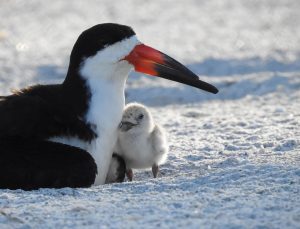
A small program once run by volunteers from St. Petersburg Audubon Society has morphed into the nation’s largest campaign to protect beach-nesting birds from human activity.
Now part of Audubon Florida, hundreds of bird stewards will be needed this summer at St. Petersburg Beach, Fort DeSoto, Three Rooker Island and Indian Shores or Indian Rocks Beach, depending upon where the birds decide to nest. (Separate programs put bird stewards on Egmont Key and Honeymoon Island.)
“I’m comfortable saying that some of these chicks would not survive if it weren’t for stewards,” said Holley Short, program manager for Audubon Florida. “Around the world, bird populations are plummeting, but we’re seeing more and more chicks hatch and successfully fledge on Tampa Bay beaches because of the people who volunteer to protect them.”
Beach-nesting birds need extra protection because they’re practically invisible. They nest in tiny scrapes in the sand and depend upon natural camouflage to protect them from predators. That may work in the case of larger birds, but it becomes a disadvantage when the danger is posed by human beings enjoying a sunny day at the beach.
“In nearly every case, beachgoers will go out of their way to avoid hurting the birds — but someone needs to tell them that they are there and explain what happens if humans or dogs get too close,” Short said. When disturbed, parents will leave their nests, exposing eggs or vulnerable chicks to hot sun or predators who can sneak in when they see adult birds fly away. Flying away also consumes energy they need to successfully raise their chicks.
While most beaches have some birds foraging on their shores, Audubon stewards are posted at those where imperiled birds are nesting. A very busy St. Pete Beach hosts the state’s second-largest population of threatened black skimmers. Other imperiled birds that nest on Tampa Bay beaches include Wilson’s and snowy plovers and American oystercatchers.

A wide variety of birds are found at Fort DeSoto Park, where a section is roped off year-round for both “snowbirds” who spend their winters here as well as birds who nest in the summer. “Having a separate sanctuary is an advantage but stewards are needed when the main part of the beach gets crowded and people sneak under the ropes,” Short said.
No Experience Necessary
Bird stewards don’t need to be bird experts, Short emphasizes, just people who want to protect wildlife in an urban setting. “We provide all the information they’ll need, including brochures and photographs of the birds and their chicks.”
Introductory classes are scheduled for this spring with a focus on how to educate beachgoers on why it’s so important to give the beach-nesting birds the space they need to successfully rear their chicks. They’ll last about an hour, followed by a beach walk when possible.

March 14th, 9-11 am: Fort DeSoto. Meet at the North Beach snack bar.
March 28th, 9-11 am: Siesta Key. Meet at the Sea Turtle Pavilion at the public beach.
April 14th, 5:30-6:30 pm: Three Rooker Island. Held at Moccasin Lake Nature Center in Clearwater.
May 16th, 9-11 am: Municipal Beaches (St. Pete Beach, Indian Shores/Indian Rocks, Clearwater Point). Held at Indian Shores Community Building, 4th floor.
To sign up for the trainings, contact Short at Holley.Short@audubon.org.
Other trainings will be held later in the season, including special sessions for the Fourth of July holiday, which is on Saturday this year. “It’s such a big family day that our regular stewards have other plans,” she said. “It’s also the biggest day of the year for beachgoers, the peak of nesting season and the worst day for fireworks. We always need extra volunteers that day.”
